Frequent attacks and hateful language constantly question the “Americanness” of Asian Americans and Pacific Islanders. We've seen many treat AAPI people like a "perpetual foreigner," asking them questions like "where are you from?"
But on the world stage, AAPI athletes have been part of something quite wholeheartedly American: representing the nation at the Olympics.
Those athletes made it to a highly visible stage despite these challenges of being constantly “othered” and often rendered invisible. And they have inspired others.
“Can I call myself JR Celski Jr.?” my brother Joel asks me jokingly, referring to the former Filipino-Polish Olympic speed skater. Joel is a 19-year-old in nursing school, telling me what could have been when he decided to become a speed skater almost 10 years ago.
Joel can barely remember it, but our Filipino family, freshly immigrated to the United States from New Zealand in 2006, watched in unending excitement as Celski entered the national stage when he first qualified for Team USA at the 2010 Vancouver Winter Olympics.
“I think it was seeing all your reactions about how hyped it was,” my brother tells me. “Like, dang, I want that feeling.” So months later, he picked up his first pair of skates and tried his luck on the ice. “I’ve always wanted to do something fast,” he says, and beating people, “especially on ice, that was one of the coolest things I could think of.”
For my brother, the experience of seeing yourself represented on screen was potentially life-changing. “It felt like it could be me,” Joel said. “Especially with JR because he was such a big inspiration to the Filipino community...he exposed that sport so much to me, that, wow, I can actually take part in that.”
Many Olympians themselves have had that same experience. Celski, too, had others to look to for inspiration. “I knew that at a certain point in my career, the tides have turned, it would be me in that position,” he told NBCLX. “Just hearing stories like your little brother is really cool to hear, because I came into the sport pretty similarly.”
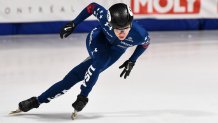
Celski, born and raised in Federal Way, Washington, got into speed skating almost by accident. It was an activity for him and his brothers to let off steam while his mother worked late hours. When he decided to get serious about competing in the Olympics, he moved to Southern California with his brother, where he lived among a large Filipino American community, watching boxer Manny Pacquiao at the height of his career, and dedicating his own life to speedskating.
For him, succeeding was about respecting his and his family’s sacrifices. To represent your country, your family, your hometown and your sport is the “highest honor,” Celski says.
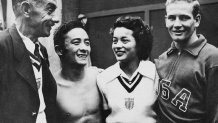
The legacy of AAPI people in the Olympics is anything but new. In fact, it stretches back to 1948 with Filipino American diver Victoria Manalo Draves, who won two gold medals just two days before her close friend and fellow diver Sammy Lee, a Korean American, also won a gold medal. They became the first Asian Americans to win gold at the Olympics, and the fact that the first prominent Asian American Olympians in history are two gold medalists speaks to the pervasiveness of the model minority myth and what it takes for minorities as a whole to be recognized for their accomplishments. Not much information, if any, is widely accessible about any Asian American Olympians who competed before them.
Tokyo Olympics
Watch all the action from the Tokyo Games Live on NBC
What It's Like Repping the U.S. Wheelchair Basketball Team For the 1st Time
“It’s not often that Asians are really celebrated in sport, in general, in the U.S., so it takes some kind of extraordinary story to really put it out there for people to take notice of that,” says Celski.
The list of Asian American Olympians has no shortage of greats. I spoke to several who shared their inspiration and hope for the future of AAPI Olympians.
Olympic Figure Skater, Mirai Nagasu
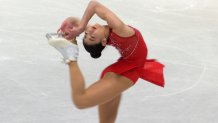
Prominent Asian American athletes have graced the stage since the late 1940s and plenty since then have become household names - like Amy Chow, of the 1996 “Magnificent 7” gymnastics team. Figure skater Mirai Nagasu says many of them have inspired her.
“I was able to believe I could become a figure skater because I had role models like Kristi Yamaguchi and Michelle Kwan,” said Nagasu, a two-time Olympian.
At the Pyeongchang games in 2018, Nagasu made history as the first American to land a complex triple axel jump during an Olympics, capping a career with seven medals representing the U.S.
During her “very, very Japanese” upbringing in Arcadia, California, Nagasu chose figure skating at a very young age. It’s a sport she says is much appreciated in Asian cultures, including Japan, and her parents pushed her to “work hard” because skating was a “big commitment.”
Nagasu describes her parents as having a “typical immigrant journey,” opening up a restaurant in Southern California after coming to the U.S. But Nagasu herself is a born-and-bred American. But former New York Times opinion columnist Bari Weiss didn’t get that memo in 2018, when she tweeted out “immigrants: they get the job done” after Nagasu’s star moment becoming the first American skater to land the triple axel.
Weiss deleted the tweet, then posted a defense of it, not acknowledging the stereotype that she perpetuated: that even when Asians are Americans, they’re still not really seen as such. While celebratory, the tweet essentially “othered” her, and that was an awkward and difficult moment even for Nagasu to grasp.
“I didn’t realize what a minority [my] community was until I moved out of California,” Nagasu admits. “To be suddenly pointed out that I’m a minority on the Olympic team, it was a huge awakening for me. To see that as a people and as a community, we are underrepresented.”
Nagasu has taken up coaching now, and believes her experience allows her to give her students more freedom to express themselves on the ice, even incorporating aspects of their heritage and identity into the choreography and music of their programs. She described one young Japanese student of hers who was offered a program themed “Mulan” which she soundly rejected because she isn’t Chinese.
As the community of Asian athletes expands and diversifies, so do the expectations that Asian Americans aren’t treated merely as a monolithic and tokenized group, nor lumped in with Pacific Islanders and Polynesians.
Olympic Water Polo Goalkeeper, Tumua Anae
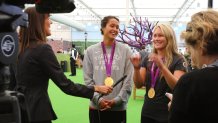
Before even Vicki Draves and Sammy Lee, there was Duke Kahanamoku. The Hawaiian Olympic swimmer known affectionately as the Father of Surfing, won his first medal at the 1912 Summer Olympics in Stockholm, taking gold in the 100-meter freestyle as part of the U.S. Olympic swimming team. He went on to win 4 more medals after that.
Hawaii especially is a hotbed for Asian and Pacific Islander athletes. Tumua Anae, a water polo goalkeeper with the U.S. team that won gold in 2012, was raised in a tight-knit Samoan family in Hawaii before moving to Newport Beach, California. Her father, an avid surfer, taught her to swim at a young age–and Anae grew up idolizing Duke Kahanamoku.
"I could relate to him on so many different levels," Anae says. Unlike basketball, volleyball, or football, Anae says water polo is not a usual choice of sport for many Polynesian athletes, something she sees slowly changing. For her, being an athlete wasn’t even about chasing gold medals or fame, but about becoming “a more well-rounded person,” getting an education, and going beyond what past generations could accomplish. But being one of the few Pacific Islander Americans with a gold medal is still a huge achievement.
“I realized that it is something that is rarely before done. It kind of hits me two ways,” Anae says. “I have always really loved that I represented our country but also represented my people, Polynesian people, and represented them in a sport that is unique.”
She notes how important her accomplishments are for the athletes who come after, and cites the “really foundational relationship” she has with her family, who always kept her very much in touch with her heritage and cultural roots, and allowed her to persevere in an extremely white-dominated sport.
“You have to expose someone to the possibility,” she continues. “Seeing someone that looks like you doing something important. The focus isn’t necessarily winning, but participating, so it opens opportunities.”
Olympic Skateboarder, Heimana Reynolds

Heimana Reynolds also grew up surfing before making the switch to his Olympic sport: skateboarding. He'll be on the U.S. team this year in Tokyo.
He says skateboard is “the closest thing to surfing when there’s no waves." Reynolds, indicative of the growing diversity within the youngest generation of Americans, is of mixed Tahitian, Hawaiian, Filipino and Chinese heritage.
“Growing up in Hawaii, my family never let us forget our roots,” Reynolds says, describing how his family emphasized living off the land and respecting it. Hawaii has a lot of Asian influence, but being from the islands, Reynolds has always been more drawn to his Polynesian heritage – and it’s not something he’s shy about.
Anyone watching Reynolds can see a tribal tattoo prominently placed on his leg – a coming-of-age kind of ritual and a piece of bodily art that is unique to his family history and background. Reynolds is exceedingly proud of what he does and where he’s from.
“Of course I’m skating for Team USA but I’m also skating for my island,” Reynolds says. “It makes me feel excited and happy that I have this island that is backing me. It’s super cool to think that I did come from this little island and now I’m going to the Olympics.”
For so many athletes operating at the highest levels of competition in the world, nothing can get between them and their sport. Reynolds especially exudes a love for skateboarding and the culture of collaboration and creativity inherent in it. When asked about how he feels about representation, Reynolds went back to his experience as a skater, surrounded by other skaters from unique backgrounds.
“The beauty of skateboarding is it accepts everyone,” he says.
Olympic Swimmer, Nathan Adrian

For other athletes of color, the importance of representation can sometimes feel a bit like a double-edged sword. Swimmer Nathan Adrian is an 8-time Olympic medalist, earning his first gold medal at the 2008 Olympics. Adrian, whose mother is Chinese and immigrated from Hong Kong, grew up in a diverse community in Bremerton, Washington.
“My Asian American heritage wasn’t a massive thing we talked about at home, but we lived it,” Adrian says, citing the diversity in his hometown as significant to shaping his opinions and thought processes regarding race as he grew older. Even on his own team, Adrian describes looking up to two biracial sisters born to a Filipina Chinese mother: Dana and Tara Kirk, who both made it to the 2004 Olympic swimming team. He concedes that his proximity to them may have “paved a short path for [him] as an individual” and drove home the idea of how his success can be an inspiration for other young athletes.
But while Adrian is proud of his heritage and actively advocates for diversity and inclusion within sports, Adrian says he doesn’t “necessarily perform better if [he tries] to elevate meaning behind his swimming performance.” It reveals the fine line many athletes of color have to navigate between motivation and pressure, or representation versus tokenization.
“I try to be a role model because of the actions and decisions that I make, not necessarily heritage,” Adrian says. “I don’t make a decision because I am representing Asians in sports...I just want to be a good human and a good person.”
Olympic Takewondo Athlete, Paige McPherson
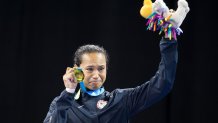
For those who didn’t grow up in diverse settings, the only way to succeed is by looking inwards. That was the case for taekwondo athlete Paige McPherson, who is Black and Filipino, and grew up in Sturgis, South Dakota to a “rainbow family” consisting of five children adopted domestically and internationally. She was first introduced to taekwondo because her parents wanted her older brother, Kevin, who is of Korean descent, to “understand something of his culture.” It filtered down to her.
Though she grew up “essentially in a white culture” without the typical connections to her specific ethnic roots, McPherson said her parents were open about her differences and celebrated them. And for her, taekwondo was something she excelled in, but also felt like “an extension of [her] family.” Now as an adult living in the multicultural city of Miami, she’s embraced her Filipino side wholeheartedly and credits close family friends with nurturing her connection to the culture.
McPherson made it through Olympic trials and will again represent the U.S. in taekwondo at the Tokyo games.
Though she didn’t have the same kind of representation that others might see in her, McPherson appreciates the importance of telling her truth: “Seeing something that you can relate to gives you that motivation and inspiration. A lot of my inspiration came from people that were around me that I could relate to.”
For her, the value in the Olympics is in “embracing diversity and individuality” and “seeing these people of different backgrounds learning to love themselves and go for their dreams.”
Little do they know, so many like my brother Joel are out there dreaming to be just like them.

